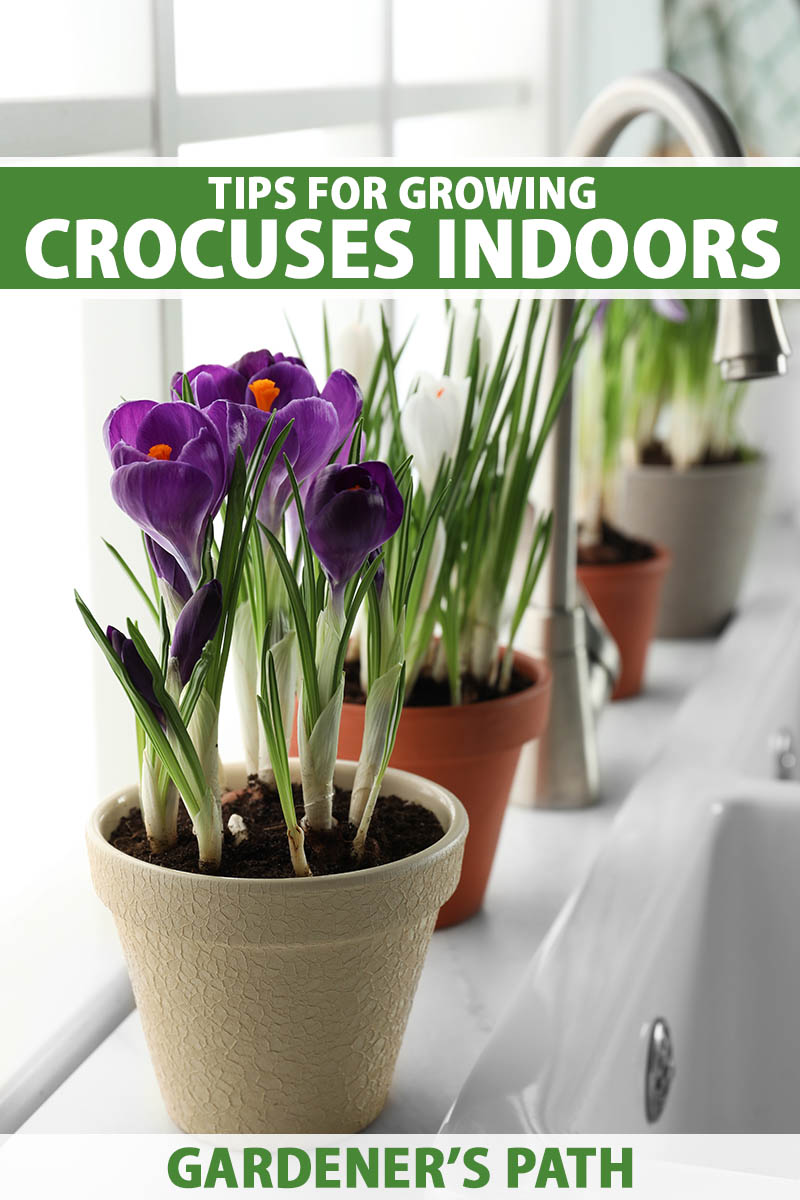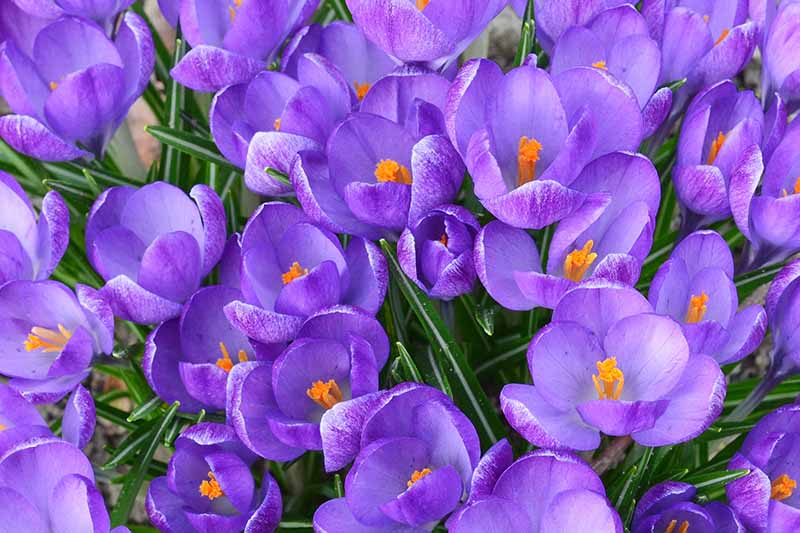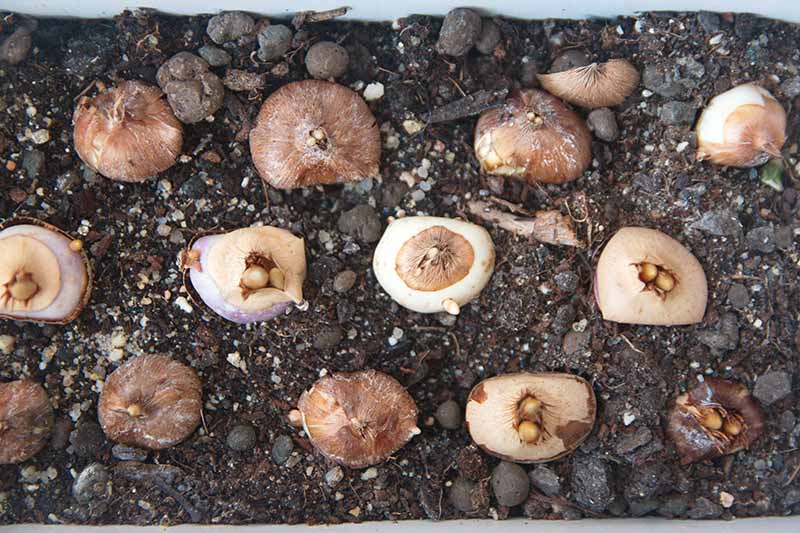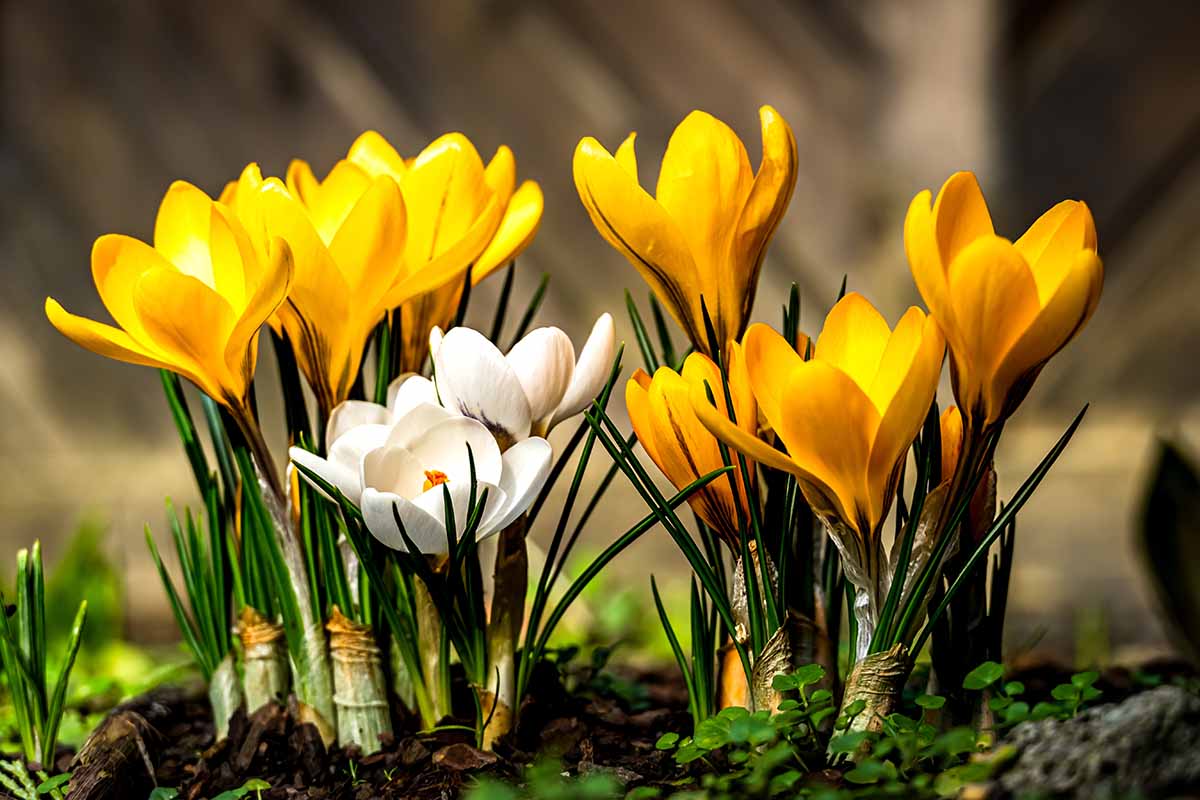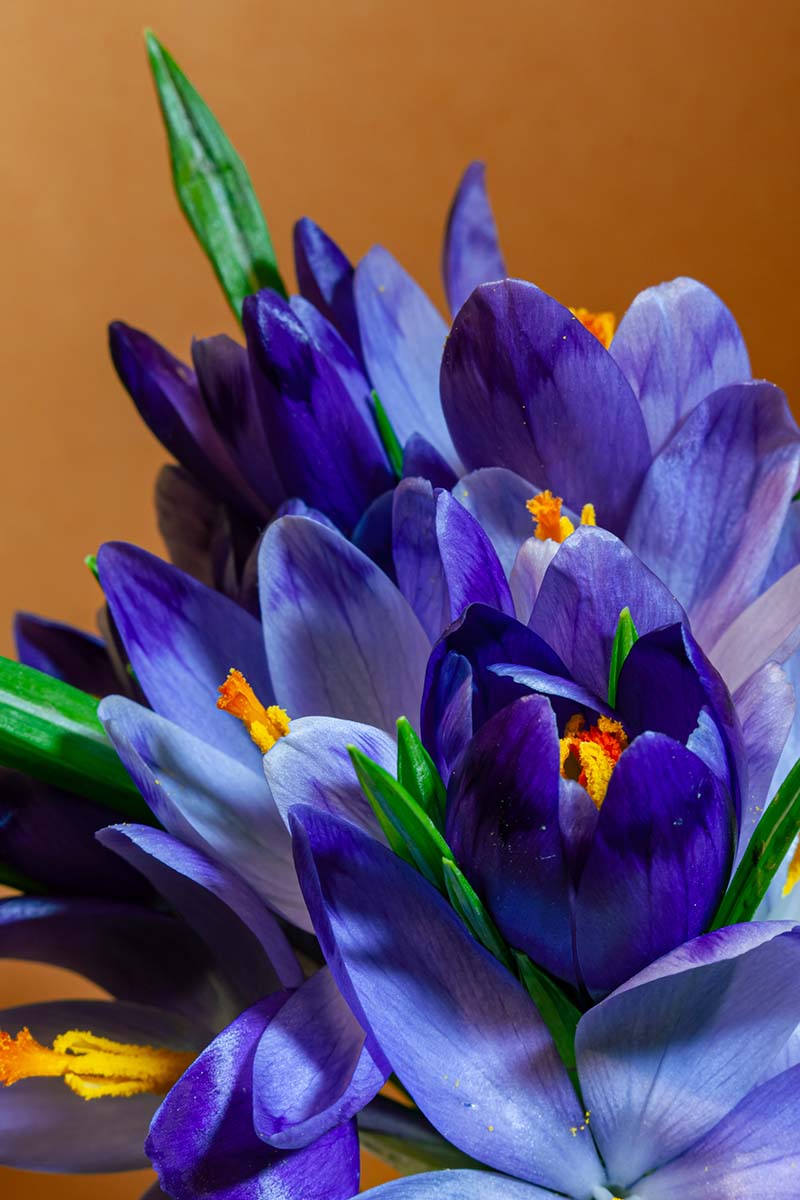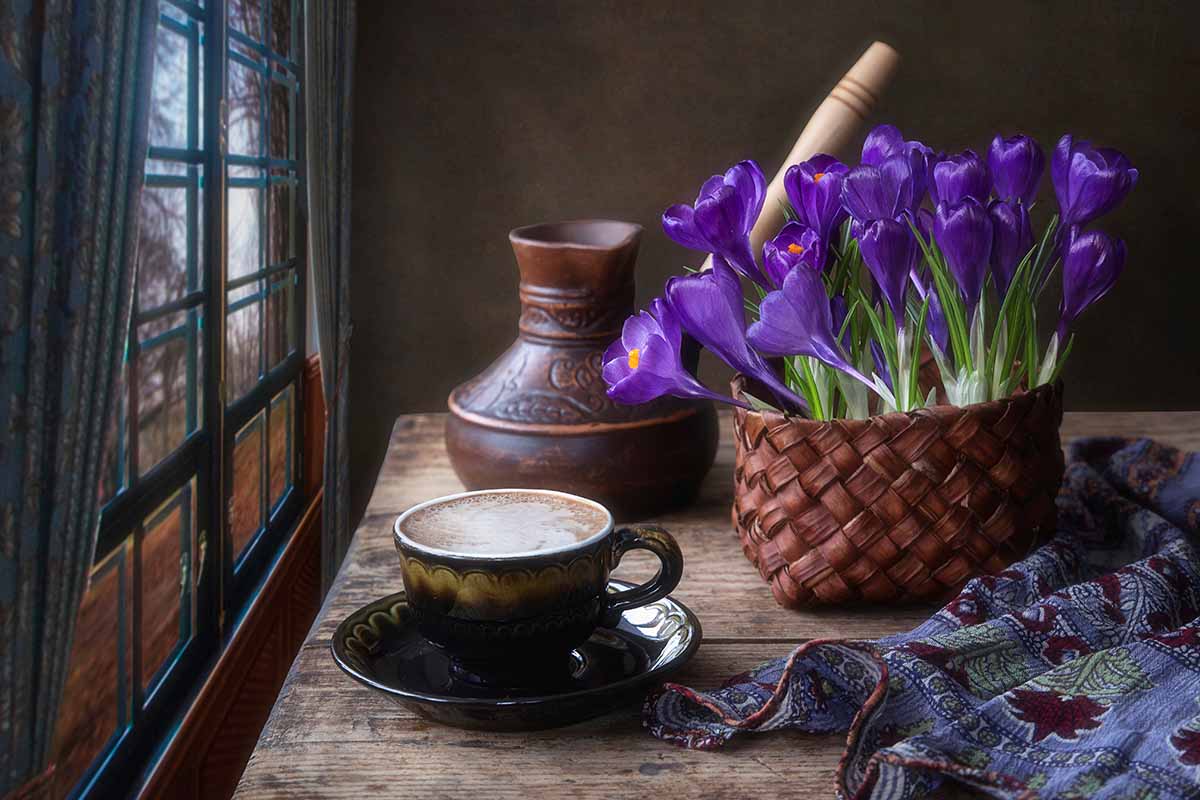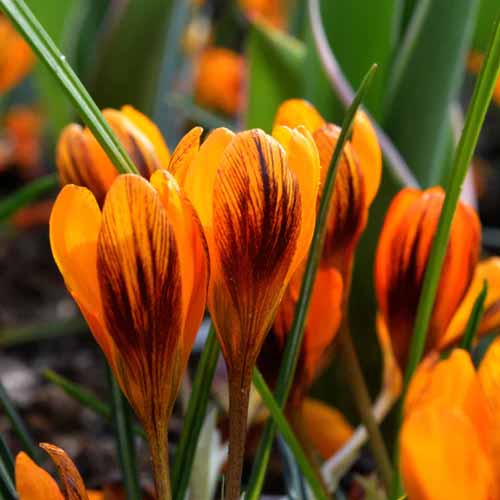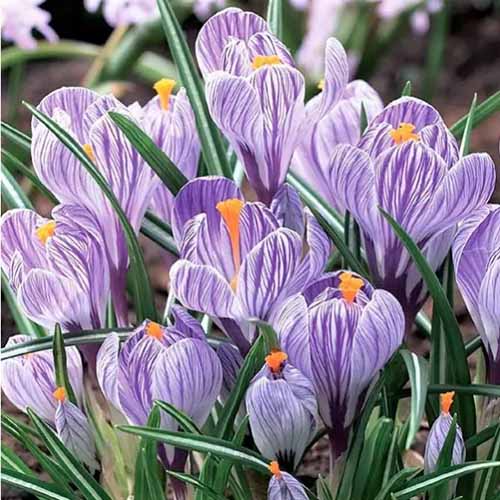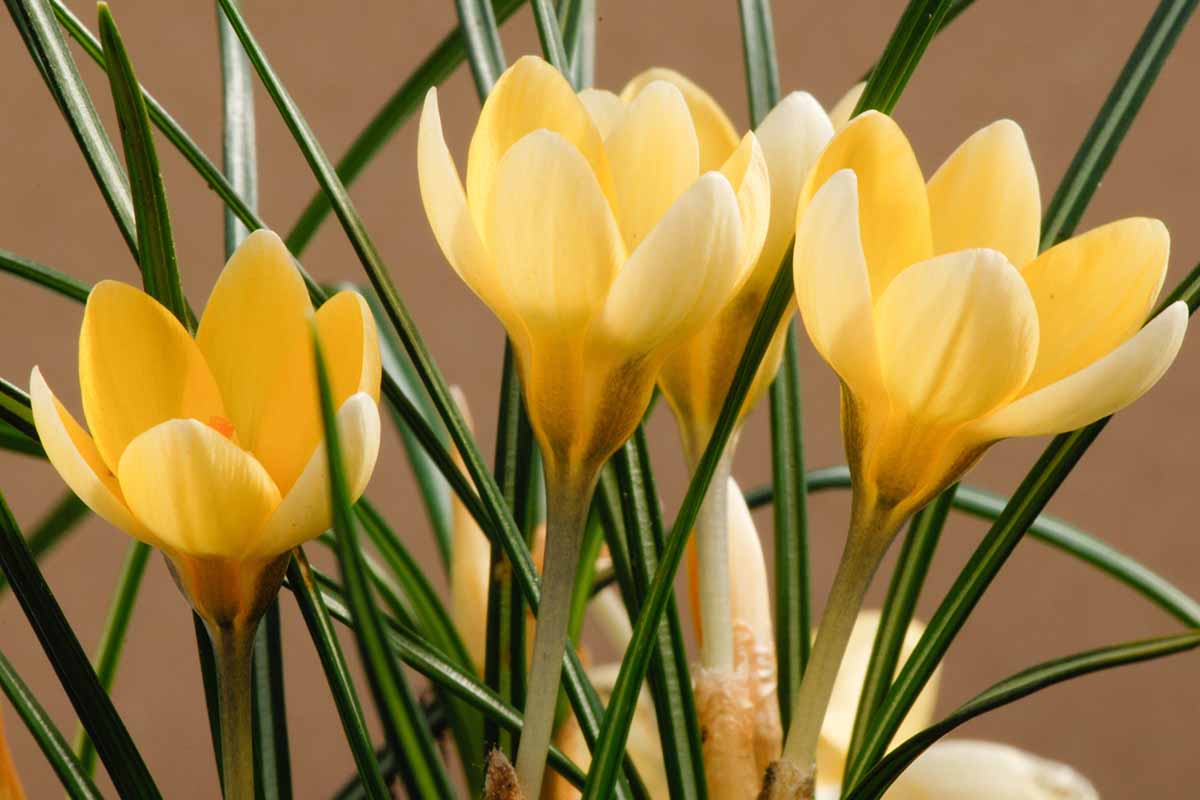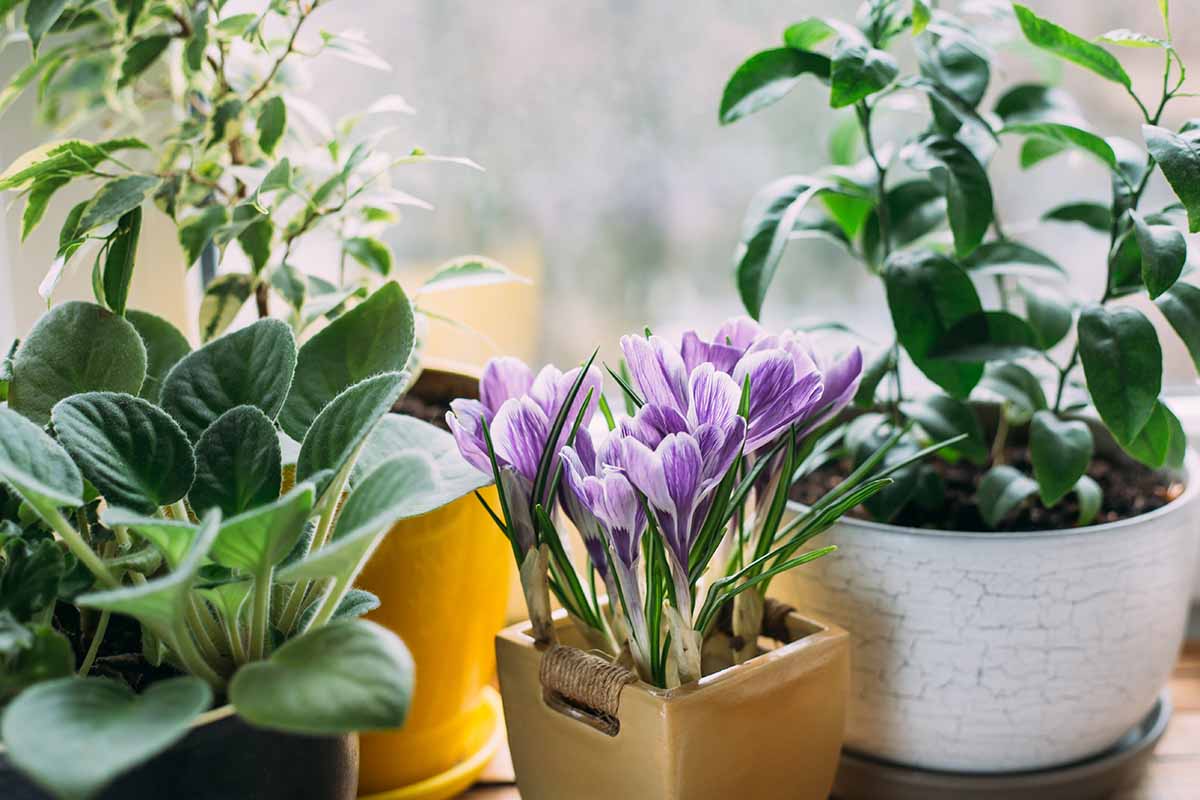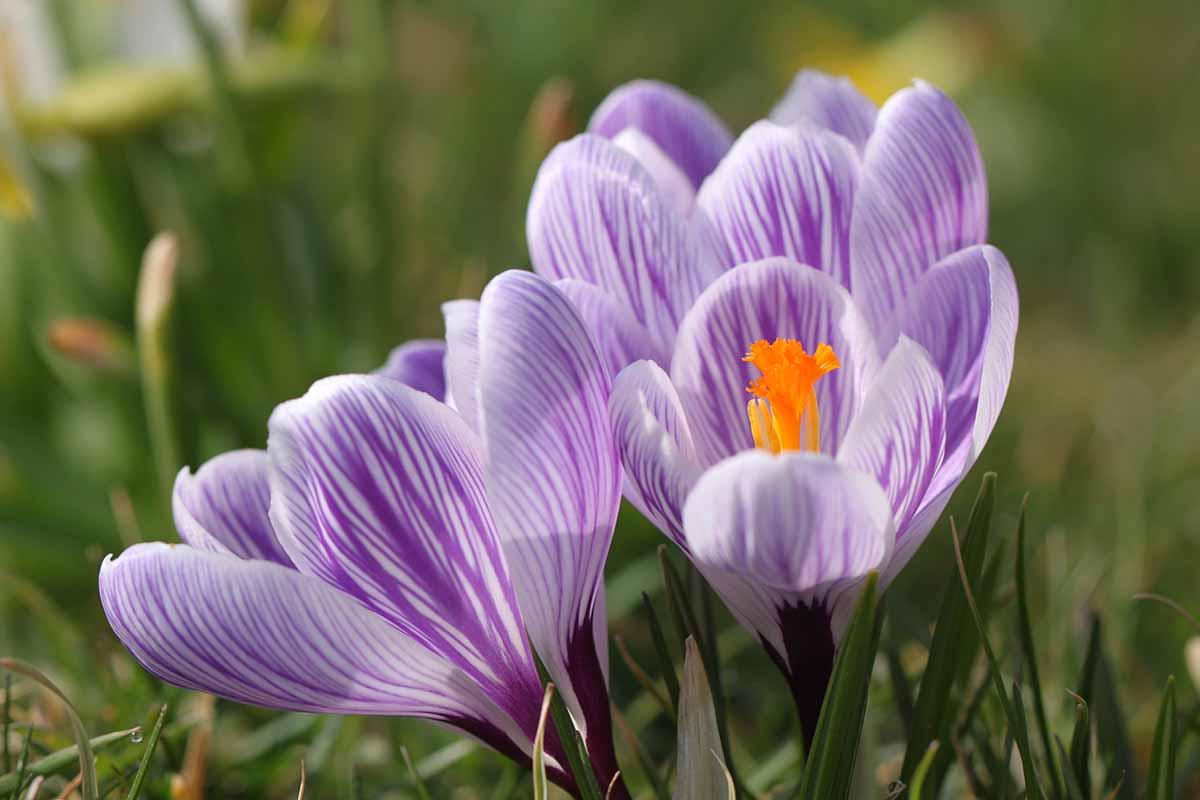So majestic is their beauty that some gardeners may long to enjoy these flowers indoors. And you can do that! We link to vendors to help you find relevant products. If you buy from one of our links, we may earn a commission. How awesome is that? Tricking a flower to emerge earlier than usual, and inside the house? That’s botanical wizardry, right there. Plus, crocuses are a cinch to care for indoors when you know how… and that’s where this guide comes in. We’ll cover the ins and outs of caring for these plants inside, along with their interesting botanical backstory. Here’s the plan for this article:
What Are Crocuses?
Consisting of more than 90 different species, the Crocus genus belongs to the family Iridaceae, along with irises, freesias, and gladioli. These plants are herbaceous perennials that grow from corms, i.e. short, vertical, modified stems that store food so they can survive the winter. Depending on the species, these plants flaunt beautiful cup-shaped flowers that come in white, pink, yellow, orange, blue, and purple, and the plant as a whole tends to grow two to six inches tall, with a spread of three to six inches. Most bloom in spring, but a few species like the saffron or autumn crocus (C. sativus) blossom in the fall. These are not to be confused with species of Colchicum, also commonly referred to as autumn crocuses, which belong to the lily family. The hardiness of a crocus depends on its bloom time. Spring-blooming types are hardy in USDA Zones 3 to 8, while fall-blooming varieties are best grown in Zones 6 to 10. If you want to know more about growing crocuses in the garden, check out our complete guide. For indoor growing, it’s ideal to stick with the spring-blooming kinds, since the tried-and-true bulb forcing protocols that we’ll get into later were designed to work with the physiology of these types.
How to Grow
When growing crocuses indoors, you’ll have to “force” the corms to bloom, which involves manipulating the environment to artificially recreate the outdoor conditions that dictate bloom time. Since forcing corms severely reduces their vitality – and greatly lowers their chances of ever flowering again – it’s advisable to throw them away after the flowers fade, or to at least lower your expectations regarding the magnificence of the blooms in subsequent seasons. Propagating corms can be done with spring-flowering species or fall-flowering ones.
Growing Spring-Flowering Crocus from Corms
First things first: you’ll need some crocus corms. You can purchase these, or offsets can be divided from outdoor specimens for transplanting. For specific recommendations, head on down to the “Species and Varieties to Select” section of this guide. Plant them 14 to 20 weeks prior to the date that you desire crocus blooms. Select a five-inch-wide pot that’s at least five inches deep with a drainage hole at the bottom, and a saucer to place beneath it. Fill it with a well-draining soilless growing media that’s an equal mix of peat moss, shredded bark, perlite, and sand. Plant the corms pointy-ends-up and half an inch deep. Place them close enough together so that they’re almost touching. Cover the corms with potting mix, then water thoroughly to moisten. Discard any excess that has collected in the drainage saucer. Next up: chilling the corms. You’ll need to place the pot in a dark location with a temperature that’s above freezing but below 40°F, whether that’s a refrigerator, basement, or garage. If you’re keeping the pot in a refrigerator, make sure there aren’t any unbagged fresh fruits inside, as the ethylene gas they emit could interfere with flower development. Additionally, ensure that any pot you place in a fridge that also holds food is contained in a plastic bag. Once you have the pot in an ideal location, keep it there for 12 to 15 weeks, making sure to water deeply whenever the surface of the potting mix feels dry. When you hit week 12, check the pot for fleshy white roots poking out the bottom. If you don’t see any, wait a bit longer and check again, about once a week. Remove the pot from cold storage either when you notice roots or when 15 weeks are up, whichever comes first. Place the pot next to a bright window where it will receive four to six hours of sunlight in a room where temperatures don’t exceed 65°F. Blooms should appear two to five weeks after the pot’s removal from cold storage for spring-blooming types. Once the blooms fade, the corms can be pitched or composted. Osmocote Smart-Release Plant Food Continue to provide water whenever the surface of the soil feels dry, irrigating until water starts to run out of the drainage hole. Sitting the pot on a saucer or plate will contain any excess water, which should be dumped out after watering. They don’t have to be, but they’ll typically take at least two years to bloom well again, so it’s your choice. Personally, I’d rather use new corms to ensure strong blooms each and every year. But feel free to keep them until it’s time to start forcing the corms to produce blooms once more. If you go with the latter option, keep the pot in the same sunny location in your home and continue to provide water whenever the surface of the growing medium feels dry. But do not overwater – crocuses can withstand some drought, and you don’t want the bulbs to rot. Deadhead the blooms when they are spent, but wait to remove the foliage until it’s brown and withered. Once blooms appear in six to eight weeks, you can remove the heating pad and begin watering whenever the top inch or two of soil feels completely dry. Saffron Crocus These corms don’t need to be forced with cold temperatures prior to planting – they can be planted in a pot at any time, preferably soon after you receive them. Make sure to use a pot, growing medium, planting depth, and corm spacing similar to what you would use for spring-flowering varieties. Place the pot in a room with temperatures of about 70°F in an area where it will receive four to six hours of sunlight per day. Utilize a heating pad to mimic the hot temperatures of summer, such as this 48-by-20-inch electric heat mat from Gardener’s Supply. Electric Heat Mat Water the corms deeply a single time, then wait six to eight weeks before watering again. They typically require a prolonged warm and dry period during summer dormancy when grown outside, followed by a period of wetter and cooler weather. After flowers bloom, edible saffron can be harvested and dried for culinary use. If saffron crocus is the fall-blooming variety you went with, feel free to harvest the stigmas from fresh flowers that have bloomed fully. At mid-morning on a sunny day, hand-pluck the stigmas from each flower and leave them out to dry in a bright, sunny place indoors. Store in an airtight container with a lid in a cool, dark place for later use in cooking. For more information on saffron spice and its culinary applications, check out this guide from our sister site, Foodal. Once the blooms are spent, you can deadhead them. Wait until the foliage has browned and withered to remove it. At this point, you can leave the corms alone and unwatered in a room that’s similarly lit and kept at 70°F until a year after the initial planting date, at which point you’ll start the process over again – although your mileage may vary on if or how well the corms will bloom again indoors. For guaranteed blooms, you’d be better off planting fresh.
Growing Tips
After chilling, provide full to partial sun exposure for optimal growth.An application of a slow-release granular fertilizer upon the plant’s removal from cold storage is ideal to encourage healthy, long-lasting blooms.Irrigate the growing media whenever the soil feels dry to the touch.
Maintenance
Maintenance for a crocus houseplant isn’t very intensive. If any leaves turn brown or when blooms fade, feel free to snip them off. It wouldn’t hurt to give the pot a quarter turn each day, either, to optimize light exposure.
Cultivars to Select
There are quite a few kinds of Crocus that are fit to be houseplants. We’ve even covered top-tier varieties to grow at home in this roundup. But if I had to choose a few cultivars worthy of growing indoors, these would be my top picks: Proper and sanitary cultivation is the best way to prevent infestations and infections from occurring – a healthy organism is a robust organism. Growing to a max height of four inches, the outsides of the bright orange petals are emblazoned with vertical lines of purplish-brown, and the entire flower gives off a glowing look when the sun hits it just right, kinda like a lava lamp. If you’re planning your indoor decor with a certain color palette in mind, this Fanta-orange hue complements purple or green quite nicely. ‘Orange Monarch’ Dutch Grown offers a primo pack of 25 ‘Orange Monarch’ bulbs for sale.
Pickwick
Along with dazzling color and a full-grown height of four to six inches, the C. vernus ‘Pickwick’ offers an interesting visual texture. The petals display vertical and branching stripes of purple on a white background, which – if I can make a visual comparison – look a lot like the fibers of a nervous system diagram, or something you might see on the leaves of a nerve plant. Orange-colored stigmas complement the purple and white petals quite well, which makes for quite the ornamental cherry on top. The flowers of this cultivar – and of C. vernus in general – are larger than most other kinds of crocus, so an arrangement of ‘Pickwick’ may appear densely packed in a container, which is a pretty awesome look in its own right. ‘Pickwick’ If this cultivar is appealing, Nature Hills Nursery offers a 15-pack of high-quality ‘Pickwick’ corms.
Romance
A dazzling beauty, the ‘Romance’ cultivar of C. chrysanthus reaches mature heights of four to six inches, and has more of a softer yellow to its flower petals than the starkly golden hue of the standard species. The outsides of said petals are such a light yellow that they appear almost white, while the insides of the petals are darker yellow. With orange stigmas and an orange throat, you have a stunning color gradient for the eyes to follow!
Tricolor
Reaching heights of four to six inches when fully grown, C. sieberi ‘Tricolor’ is perfect for those who can’t decide between white, yellow, or lavender flowers. As the name implies, these rock all three shades, with yellow bases, lavender tips, and a stripe of white dissecting the middle of the petals. Not to mention their golden sepals and orange stigmas, which are a nice visual dessert to complement a gorgeous main course. ‘Tricolor’ Packs of 15 ‘Tricolor’ corms are available from Burpee.
Managing Pests and Disease
Although they are resistant to deer, species of Crocus are susceptible to a couple of notable rodents, insects, and diseases. Rodent pests such as squirrels, voles, chipmunks, rabbits, and mice are all worth worrying about when your crocuses are grown outside… but in the context of indoor growing, these small herbivores aren’t typically a pressing concern.
Pests
Pests tend to be vectors for pathogens, so staying on top of pest management comes with the fringe benefit of reducing disease occurrence.
Bulb Mites
Species of Rhizoglyphus known commonly as bulb mites are very tiny: about one-half to three-quarters of a millimeter long when fully grown. Their oval-shaped soft bodies are colored white with spots of amber, and their brown legs move them along so slowly that they can be mistaken for eggs. These pests enter bulbs to feed, often spreading pathogenic Fusarium, Stromatinia, and Pseudomonas fungi as they do so. Stunted growth plus distorted and chlorotic leaves are primary aboveground symptoms, while the bulbs themselves will often display rot and reddish-brown discoloration. You can disinfect bulbs before planting by soaking them in water kept at 110°F for 30 minutes. Cleaning bulbs with water and then dipping them in sulfur fungicide is another option. Regardless of the treatment method used , be sure to allow the bulbs to dry completely afterwards. If plants show signs of infestation, your best bet is to toss the bulbs and soil. Disinfect containers, and start fresh.
Root-Knot Nematodes
Root-knot nematodes are a group consisting of about a hundred or so species of plant-parasitic nematodes from the genus Meloidogyne, and their presence does not bode well for plants. The primary symptoms of root-knot nematode infestation are large knots or galls on the root system, but wilting and stunted growth in the shoots may be the first sign of a problem. Utilizing fungicides and biological microorganisms that feed on nematodes are both effective forms of treatment, but given that you’re growing these crocuses indoors, it would probably be best to just start over after pitching the infested corms and growing media as noted above. You can read more about root-knot nematodes in our guide.
Disease
It’s impossible to prevent disease a hundred percent of the time, but you can prevent the majority of pathogens from taking hold by utilizing sanitary gardening practices such as sanitizing tools and using disease-free corms and potting mix. Here are a few ailments to be aware of:
Corm Scab
Corm scab is caused by the bacterium Burkholderia gladioli pv. gladioli. Although its name references its preference for attacking gladiolus corms, it may also damage species of Crocus. The surface of infected corms displays shallow black lesions, which can cause premature leaf chlorosis and death to plant parts above the soil line. When corm scab is identified, remove and destroy any infected corms, and discard the growing media. Bulb mites can often spread this disease.
Mosaic Viruses
Infecting more than 150 different kinds of plants, mosaic viruses notably mottle foliage with yellow and green markings, and infected plants may display broken or streaked color on the flower petals as well. In addition to these cosmetic symptoms, stunted growth is typical. There aren’t any known cures for mosaic viruses, so scrapping any infected corms and growing media will be your best bet. Mosaic viruses aren’t always fatal, so if the symptoms don’t significantly detract from the beauty of your plants, don’t feel like you have to take immediate action… unless, of course, the infected crocus is near other healthy specimens that may be susceptible. Isolating and quarantining the sickly plant is essential for keeping your remaining houseplants disease-free.
Best Uses
When grown in your home, crocuses make lovely windowsill plantings. If you’re forcing other flowering bulbs indoors such as daffodils or tulips, adding some crocuses in the midst of those plantings to bloom first will result in a gorgeous, ongoing display. Since the color, shape, and upright form of these plants are prominent features, placing them in the vicinity of your typical foliage-dominant, cascading houseplants such as pothos, Boston ferns, or spider plants would be a wise aesthetic choice. And tricking a crocus is even easier than tricking a person! After utilizing the knowledge gleaned from this guide, your crocus plants will bloom indoors earlier than they would have if they were growing outside in the ground. How’s that for setting the clocks forward? Comments or questions about growing these plants indoors can go in the comments section below. The experiences of fellow plant people are invaluable for growing ourselves as gardeners! For even more crocus know-how, check out these guides next:
9 Reasons Your Crocus May Not BloomCan Crocus Grow in the Cold and Snow?When to Plant Crocus Bulbs
